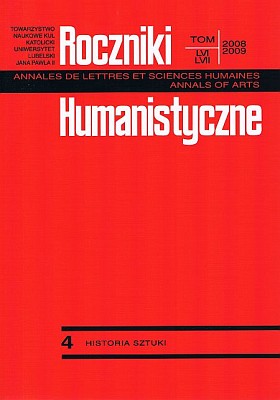Formal and Material Eclecticism in Franciszek Streitt’s Realistic Paintings
Abstract
Analysing Franciszek Streitt's painting and the course of his carrier, one may distinguish three stages: the Cracow, Vienna, and Munich stages. His sojourn in Cracow is devoted above all to the studies of painting at the Jan Matejko and Władysław Łuszczkiewicz Art School. It is owing to Matejko that Streitt historical paintings with genre contents, e.g. The Farewell to the Son Leaving for Vienna. Władysław Łuszczkiewicz's influence can be observed in portraits, whereas Izydor Jabłoński's in religious themes. Moreover, in Cracow Streitt made friends with Antoni Kozakiewicz and Aleksander Kotsis.
In 1868, Streitt and Kozakiewicz went to Vienna where they entered the Art School. In Vienna, Streitt made a cycle of paintings that referred to Adam Mickiewicz's poetry. They were the following Świtezianka, Kataryniarz [The Organ-Grinder], Czaty [The Watch], and Wojewoda [The Voivode]. He also painted historical compositions: Porwanie Halszki z Ostroga [Halszka's Abduction from Ostróg], Katarzyna Jagiellonka w Grypsholm [Katarzyna Jagiellonka in Grypsholm] (in Matejko's convention), Rekrutacja [Conscription], and Ostatnie odwiedziny [The Last Visit] (they deal with the repressions after January uprising).
In 1871, he left for Munich. In the capital of Bavaria the artist came closer to Józef Brandt's group. His painting enjoyed great interest there. Many of his works were bought by Kunsttraders, and then they sold them to England and the United States. He became an ordinary member of the Munich Kunstverein in which he exhibited many of his works. He often arrived in the vicinity of Galicia and in Hungary, where he had found many themes and motifs for his painting. In Munich, he painted paintings that concerned a very broad theme, mainly genre compositions. They most important are the following cycles: wandering musicians, Gipsies, shoemaker's apprentices, beautiful aristocrats, and the compositions that exhibited poverty. Now with regard to artistic value, the most important are Na gorącym uczynku [Caught Red-Handed], W małem miasteczku [In a Small Town].
One can find in the artist's composition some influences of Maksymilian Gierymski, Antoni Kozakiewicz, Alfred Wierusz-Kowalski, and Władysław Czachórski.
Copyright (c) 2009 Roczniki Humanistyczne

This work is licensed under a Creative Commons Attribution-NonCommercial-NoDerivatives 4.0 International License.





